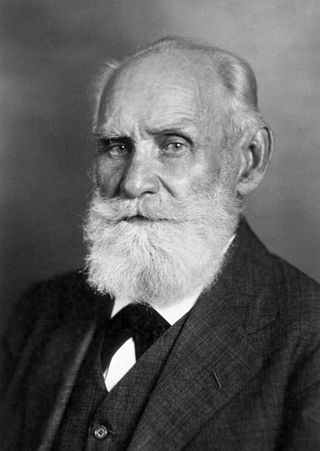
Ivan Petrovich Pavlov was a Russian and Soviet experimental neurologist and physiologist known for his discovery of classical conditioning through his experiments with dogs.

Ilya Yefimovich Repin was a Ukrainian-born Russian painter. He became one of the most renowned artists in Russia in the 19th century. His major works include Barge Haulers on the Volga (1873), Religious Procession in Kursk Province (1880–1883), Ivan the Terrible and His Son Ivan (1885); and Reply of the Zaporozhian Cossacks (1880–1891). He is also known for the revealing portraits he made of the leading Russian literary and artistic figures of his time, including Mikhail Glinka, Modest Mussorgsky, Pavel Tretyakov, and especially Leo Tolstoy, with whom he had a long friendship.

Peredvizhniki, often called The Wanderers or The Itinerants in English, were a group of Russian realist artists who formed an artists' cooperative in protest of academic restrictions; it evolved into the Society for Travelling Art Exhibitions in 1870.
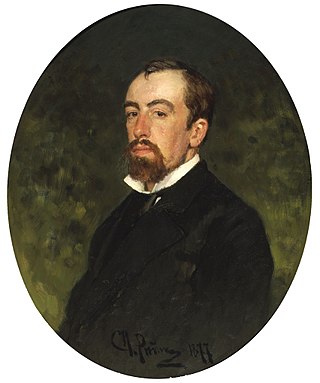
Vasily Dmitrievich Polenov was a Russian landscape painter associated with the Peredvizhniki movement of realist artists. His contemporaries would call him the “Knight of Beauty” as he embodied both European and Russian traditions of painting. His vision of life was summarized as following: “Art should promote happiness and joy”. As a painter and a humanist, he would truly believe in the civilizing mission of Art, Culture and Education.

Vladimir Mikhailovich Bekhterev was a Russian neurologist and the father of objective psychology. He is best known for noting the role of the hippocampus in memory, his study of reflexes, and Bekhterev’s disease. Moreover, he is known for his competition with Ivan Pavlov regarding the study of conditioned reflexes.
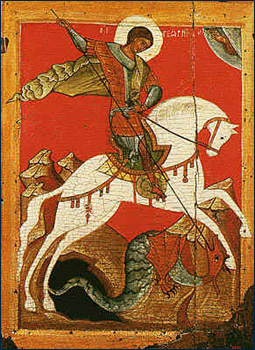
Among the collections of the Russian Museum in Saint Petersburg in Russia are some of the greatest pieces of Russian art in the world.

Mikhail Vasilyevich Nesterov was a Russian and Soviet painter; associated with the Peredvizhniki and Mir iskusstva. He was one of the first exponents of Symbolist art in Russia.
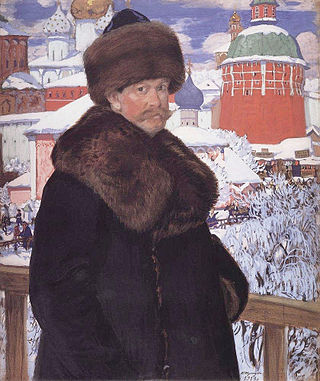
Boris Mikhaylovich Kustodiev was a Russian and later Soviet painter and stage designer.

Pavel Dmitriyevich Korin was a Russian painter and art restorer. He is famous for his preparational work for the unimplemented painting Farewell to Rus.
Anton Pavlovich Losenko was a Russian neoclassical painter and academician who specialized in historical subjects and portraits. He was one of the founders of the Imperial Russian historical movement in painting.

Leon Abgarovich Orbeli was an Armenian physiologist active in the Russian SFSR. He was a member of the Academy of Sciences of the Soviet Union and Armenian National Academy of Sciences. Leon Orbeli became the director of the Institute of Physiology in 1950.

George Dawe was an English portraitist who painted 329 portraits of Russian generals active during Napoleon's invasion of Russia for the Military Gallery of the Winter Palace. He relocated to Saint Petersburg in 1819, where he won acclaim for his work from the artistic establishment and complimentary verses by Pushkin. He was the son of Philip Dawe, a successful mezzotint engraver who also produced political cartoons relating to the events of the Boston Tea Party. One of his brothers was Henry Edward Dawe, also a portraitist. He died on 15 October 1829 in Kentish Town, United Kingdom.

Ivan Mikhaylovich Sechenov was a Russian psychologist, physiologist, and medical scientist.

Arseny Nikiforovich Semionov was a Soviet painter and art teacher, lived and worked in Leningrad, a member of the Leningrad Union of Artists, regarded as one of the representatives of the Leningrad school of painting, most famous for his landscape and cityscape paintings.

Mikhail Alexandrovich Kaneev was a Soviet Russian painter and art teacher, lived and worked in Leningrad, a member of the Leningrad Union of Artists, regarded as a known representative of the Leningrad school of painting, most famous for his cityscapes of Leningrad and ancient Russian towns.

Emíl Wíesel – a painter, museum curator and a board member of the Imperial Academy of Arts, Russia, organizer of international art exhibitions, councilor of Hermitage and Russian museum and Legion of Honor holder. During soviet times he was an expert in Russian and Western fine arts and sculpture in the Glavnauka museum department.
The Fine Arts of Leningrad retrospective exhibition became the largest showing of Leningrad artists in the Soviet History outside the city, as well as in total one of the most important art exhibitions in USSR of the 1970s. The exhibition took place in the Moscow Manezh.

Ivan the Terrible and His Son Ivan on 16 November 1581 is a painting by Russian realist artist Ilya Repin made between 1883 and 1885. It depicts the grief-stricken Russian tsar Ivan the Terrible cradling his dying son, the Tsarevich Ivan Ivanovich, shortly after Ivan the Terrible had dealt a fatal blow to his son's head in a fit of anger. The painting portrays the anguish and remorse on the face of the elder Ivan and the shock and heartbreak of the dying Tsarevich, shedding a tear at the unexpected betrayal and shock of having been killed by his father's hands.
Emmanuil Semenovich Enchmen (1891–1966) was a Soviet behaviourist and biologist. He formulated the "Theory of New Biology", often abbreviated TNB, which became popular among the Soviet student youth in the early 1920s. Considered politically, Enchmen's philosophy is an example of ″vulgar materialism″, a term often used by Marxist detractors. It was pejoratively called Enchmenism, especially when coupled and contrasted with the Mininism of Sergey Konstantinovich Minin and the Deborinism of Abram Deborin.
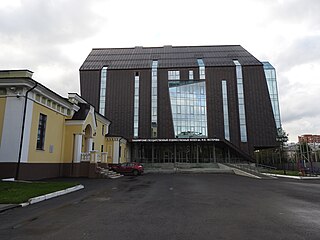
The Bashkir Nesterov Art Museum is an art museum in Ufa, Bashkortostan, Russia. It was established in 1920 by the Government of Bashkortostan. The museum was named in honor of Mikhail Nesterov, a Russian painter and Ufa native.

















